Molecular Dynamics Simulation of NiTi Shape Memory Alloys Produced by Laser Powder Bed Fusion: Laser Parameters on Phase Transformation Behavior
Abstract
:1. Introduction
2. Simulation Processes and Methods
2.1. Potential for Molecular Dynamics Simulation of NiTi Alloys
2.2. Simulation Procedure
2.2.1. The Deposition Process of NiTi Powders
2.2.2. NiTi Powder Spreading Process
2.2.3. Laser Fusion Process
2.2.4. Phase Transformation of NiTi Alloys
3. Results and Discussion
3.1. The Study of Powder Deposition and Rolling Process
3.1.1. Adsorption Behavior during the Deposition of NiTi Powders
3.1.2. Dynamic Evolution and Force Analysis of NiTi Alloys during Spreading Process
3.2. Effects of Laser Parameters on Elemental Content in Molten Pool during L-PBF
3.3. Influence of Different Element Content on the Phase Transformation Behavior
4. Conclusions
- Adsorption and accumulation of granulated NiTi powders occur during the deposition process. Increasing the powder deposition rate and reducing the granulated powder size could reduce pore size. Internal stresses are present in the deposited atoms after deposition.
- Rolling processes can reduce the number of micro-pores and defects. The friction is stable during the rolling process. The interaction of the adsorbed atoms with the deposited atoms leads to a significant increase in normal force under the action of the roller.
- The effects of laser power, spot diameter, and scanning speed on the molten pool size and element evaporation were studied. A larger spot diameter and a lower Es leads to a higher Ni content in the molten pool. A faster scanning speed and a lower Es leads to a higher Ni content in the molten pool.
- The Ni or Ti element is difficult to evaporate when the laser power is small and laser spot diameter is large. The element in the molten pool expresses a great evaporation effect when the Es is larger than a threshold of 0.4 eV/ų.
- The characteristic phase transformation temperature increases and then decreases as the Ni content changes from 48.0% to 51.0%. The variation of the austenite boundary content and the Ni content within the boundary for different Ni content account for the change of the characteristic phase transformation temperature.
Author Contributions
Funding
Institutional Review Board Statement
Informed Consent Statement
Data Availability Statement
Conflicts of Interest
References
- Bimber, B.A.; Hamilton, R.F.; Keist, J.; Palmer, T.A. Anisotropic microstructure and superelasticity of additive manufactured NiTi alloy bulk builds using laser directed energy deposition. Mater. Sci. Eng. A 2016, 674, 125–134. [Google Scholar] [CrossRef]
- Hamilton, R.F.; Bimber, B.A.; Taheri Andani, M.; Elahinia, M. Multi-scale shape memory effect recovery in NiTi alloys additive manufactured by selective laser melting and laser directed energy deposition. J. Mater. Process. Technol. 2017, 250, 55–64. [Google Scholar] [CrossRef]
- Wang, C.; Tan, X.P.; Du, Z.; Chandra, S.; Sun, Z.; Lim, C.W.J.; Tor, S.B.; Lim, C.S.; Wong, C.H. Additive manufacturing of NiTi shape memory alloys using pre-mixed powders. J. Mater. Process. Technol. 2019, 271, 152–161. [Google Scholar] [CrossRef]
- Saedi, S.; Shayesteh Moghaddam, N.; Amerinatanzi, A.; Elahinia, M.; Karaca, H.E. On the effects of selective laser melting process parameters on microstructure and thermomechanical response of Ni-rich NiTi. Acta Mater. 2018, 144, 552–560. [Google Scholar] [CrossRef]
- Wang, X.; Yu, J.; Liu, J.; Chen, L.; Yang, Q.; Wei, H.; Sun, J.; Wang, Z.; Zhang, Z.; Zhao, G. Effect of process parameters on the phase transformation behavior and tensile properties of NiTi shape memory alloys fabricated by selective laser melting. Addit. Manuf. 2020, 36, 101545. [Google Scholar] [CrossRef]
- Zhou, Q.; Hayat, M.D.; Chen, G.; Cai, S.; Qu, X.; Tang, H.; Cao, P. Selective electron beam melting of NiTi: Microstructure, phase transformation and mechanical properties. Mater. Sci. Eng. A 2019, 744, 290–298. [Google Scholar] [CrossRef]
- Penttilä, R.; Pantsar, H.; Laakso, P. Picosecond Laser Processing–Material Removal Rates of Metals. In Proceedings of the 11th NOLAMP Conference in Laser Processing of Materials, Lappeenranta, Finland, 20–22 August 2007; pp. 502–512. [Google Scholar]
- Schille, J.; Schneider, L.; Loeschner, U. Process optimization in high-average-power ultrashort pulse laser microfabrication: How laser process parameters influence efficiency, throughput and quality. Appl. Phys. A 2015, 120, 847–855. [Google Scholar] [CrossRef]
- Fikry, M.; Tawfik, W.; Omar, M. Controlling the plasma electron number density of copper metal using NIR picosecond laser-induced plasma spectroscopy. Opt. Appl. 2021, 51, 365–374. [Google Scholar] [CrossRef]
- Fikry, M.; Tawfik, W.; Omar, M.M. Investigation on the effects of laser parameters on the plasma profile of copper using picosecond laser induced plasma spectroscopy. Opt. Quantum Electron. 2020, 52, 249. [Google Scholar] [CrossRef]
- Li, Y.; Guo, X.; Wang, S.; Zhao, Y.; Zhang, C.; Liu, S.; Cheng, G.J.; Liu, F. High-precision and high-efficiency copper removal by femtosecond laser in mixed hydrochloric acid-oxygen atmosphere. J. Manuf. Process. 2022, 82, 152–158. [Google Scholar] [CrossRef]
- Zhang, Y.; Jiang, S.; Wang, M. Atomistic investigation on superelasticity of NiTi shape memory alloy with complex microstructures based on molecular dynamics simulation. Int. J. Plast. 2020, 125, 27–51. [Google Scholar] [CrossRef]
- Li, G.; Yu, T.; Zhang, N.; Chen, M. The effect of Ni content on phase transformation behavior of NiTi alloys: An atomistic modeling study. Comput. Mater. Sci. 2022, 215, 111804. [Google Scholar] [CrossRef]
- Liu, S.; Lin, Y.; Han, L.; Wang, X.; Zhao, G.; Wang, G. Atomistic simulation of microstructure evolution of NiTi single crystals in bending deformation. Comput. Mater. Sci. 2021, 199, 110733. [Google Scholar] [CrossRef]
- Srinivasan, P.; Nicola, L.; Simone, A. Atomistic modeling of the orientation-dependent pseudoelasticity in NiTi: Tension, compression, and bending. Comput. Mater. Sci. 2018, 154, 25–36. [Google Scholar] [CrossRef]
- Song, Z.; Tang, X.; Chen, X.; Fu, T.; Zheng, H.; Lu, S. Nano-indentation and nano-scratching of pure nickel and NiTi shape memory alloy thin films: An atomic-scale simulation. Thin Solid Films 2021, 736, 138906. [Google Scholar] [CrossRef]
- Wang, Y.; Zhou, X. Molecular Dynamics Simulation of Fe-Based Metal Powder Oxidation during Laser Powder Bed Fusion. Materials 2022, 15, 6394. [Google Scholar] [CrossRef]
- Plimpton, S. Fast parallel algorithms for short-range molecular dynamics. J. Comput. Phys. 1995, 117, 1–19. [Google Scholar] [CrossRef] [Green Version]
- Kavousi, S.; Novak, B.R.; Baskes, M.I.; Zaeem, M.A.; Moldovan, D. Modified embedded-atom method potential for high-temperature crystal-melt properties of Ti–Ni alloys and its application to phase field simulation of solidification. Model. Simul. Mater. Sci. Eng. 2019, 28, 015006. [Google Scholar] [CrossRef]
- Ko, W.-S.; Grabowski, B.; Neugebauer, J. Development and application of a Ni-Ti interatomic potential with high predictive accuracy of the martensitic phase transition. Phys. Rev. B 2015, 92, 134107. [Google Scholar] [CrossRef] [Green Version]
- Finnis, M.W.; Sinclair, J.E. A simple empirical N-body potential for transition metals. Philos. Mag. A 2006, 50, 45–55. [Google Scholar] [CrossRef]
- Lai, W.; Liu, B. Lattice stability of some Ni-Ti alloy phases versus their chemical composition and disordering. J. Phys. Condens. Matter 2000, 12, L53. [Google Scholar] [CrossRef]
- Ren, G.; Sehitoglu, H. Interatomic potential for the NiTi alloy and its application. Comput. Mater. Sci. 2016, 123, 19–25. [Google Scholar] [CrossRef]
- Mutter, D.; Nielaba, P. Simulation of structural phase transitions in NiTi. Phys. Rev. B 2010, 82, 224201. [Google Scholar] [CrossRef] [Green Version]
- Zhong, Y.; Gall, K.; Zhu, T. Atomistic study of nanotwins in NiTi shape memory alloys. J. Appl. Phys. 2011, 110, 033532. [Google Scholar] [CrossRef] [Green Version]
- Daw, M.S.; Baskes, M.I. Embedded-atom method: Derivation and application to impurities, surfaces, and other defects in metals. Phys. Rev. B 1984, 29, 6443. [Google Scholar] [CrossRef] [Green Version]
- Farkas, D.; Roqueta, D.; Vilette, A.; Ternes, K. Atomistic simulations in ternary Ni-Ti-Al alloys. Model. Simul. Mater. Sci. Eng. 1996, 4, 359. [Google Scholar] [CrossRef]
- Baskes, M.I. Modified embedded-atom potentials for cubic materials and impurities. Phys. Rev. B Condens. Matter 1992, 46, 2727–2742. [Google Scholar] [CrossRef] [PubMed]
- Ishida, H.; Hiwatari, Y. MD simulation of martensitic transformations in TiNi alloys with MEAM. Mol. Simul. 2007, 33, 459–461. [Google Scholar] [CrossRef]
- Lee, B.-J.; Ko, W.-S.; Kim, H.-K.; Kim, E.-H. The modified embedded-atom method interatomic potentials and recent progress in atomistic simulations. Calphad 2010, 34, 510–522. [Google Scholar] [CrossRef]
- Saitoh, K.-i.; Kubota, K.; Sato, T. Atomic-level structural change in Ni-Ti alloys under martensite and amorphous transformations. Tech. Mech.-Eur. J. Eng. Mech. 2010, 30, 269–279. [Google Scholar]
- Lee, B.-J.; Baskes, M.; Kim, H.; Cho, Y.K. Second nearest-neighbor modified embedded atom method potentials for bcc transition metals. Phys. Rev. B 2001, 64, 184102. [Google Scholar] [CrossRef]
- Lee, B.-J.; Baskes, M. Second nearest-neighbor modified embedded-atom-method potential. Phys. Rev. B 2000, 62, 8564. [Google Scholar] [CrossRef]
- Kim, Y.-K.; Kim, H.-K.; Jung, W.-S.; Lee, B.-J. Development and application of Ni-Ti and Ni-Al-Ti 2NN-MEAM interatomic potentials for Ni-base superalloys. Comput. Mater. Sci. 2017, 139, 225–233. [Google Scholar] [CrossRef]
- Muralles, M.; Park, S.-D.; Kim, S.Y.; Lee, B. Phase transformations, detwinning and superelasticity of shape-memory NiTi from MEAM with practical capability. Comput. Mater. Sci. 2017, 130, 138–143. [Google Scholar] [CrossRef]
- Nazareth, J.L. Conjugate gradient method. Wiley Interdiscip. Rev. Comput. Stat. 2009, 1, 348–353. [Google Scholar] [CrossRef] [Green Version]
- Parrinello, M.; Rahman, A. Polymorphic transitions in single crystals: A new molecular dynamics method. J. Appl. Phys. 1981, 52, 7182–7190. [Google Scholar] [CrossRef]
- Nosé, S. A unified formulation of the constant temperature molecular dynamics methods. J. Chem. Phys. 1984, 81, 511–519. [Google Scholar] [CrossRef] [Green Version]
- Ziegenhain, G.; Hartmaier, A.; Urbassek, H.M. Pair vs many-body potentials: Influence on elastic and plastic behavior in nanoindentation of fcc metals. J. Mech. Phys. Solids 2009, 57, 1514–1526. [Google Scholar] [CrossRef] [Green Version]
- Stukowski, A. Visualization and analysis of atomistic simulation data with OVITO–the Open Visualization Tool. Model. Simul. Mater. Sci. Eng. 2009, 18, 015012. [Google Scholar] [CrossRef]
- Prashanth, K.G.; Scudino, S.; Maity, T.; Das, J.; Eckert, J. Is the energy density a reliable parameter for materials synthesis by selective laser melting? Mater. Res. Lett. 2017, 5, 386–390. [Google Scholar] [CrossRef] [Green Version]
- Carter, L.N.; Wang, X.; Read, N.; Khan, R.; Aristizabal, M.; Essa, K.; Attallah, M.M. Process optimisation of selective laser melting using energy density model for nickel based superalloys. Mater. Sci. Technol. 2016, 32, 657–661. [Google Scholar] [CrossRef]
- Watanabe, M.; Adachi, M.; Fukuyama, H. Density measurement of Ti–X (X = Cu, Ni) melts and thermodynamic correlations. J. Mater. Sci. 2018, 54, 4306–4313. [Google Scholar] [CrossRef]
- Chen, W.; Yang, Q.; Huang, S.; Huang, S.; Kruzic, J.J.; Li, X. Laser power modulated microstructure evolution, phase transformation and mechanical properties in NiTi fabricated by laser powder bed fusion. J. Alloys Compd. 2021, 861, 157959. [Google Scholar] [CrossRef]
- Zou, P.; Bader, R. A topological definition of a Wigner–Seitz cell and the atomic scattering factor. Acta Crystallogr. Sect. A Found. Crystallogr. 1994, 50, 714–725. [Google Scholar] [CrossRef]
- Wang, F.E.; Buehler, W.J.; Pickart, S.J. Crystal Structure and a Unique “Martensitic” Transition of TiNi. J. Appl. Phys. 1965, 36, 3232–3239. [Google Scholar] [CrossRef]
- Jiang, S.-Y.; Zhang, Y.-Q.; Zhao, Y.-N.; Liu, S.-W.; Hu, L.; Zhao, C.-Z. Influence of Ni4Ti3 precipitates on phase transformation of NiTi shape memory alloy. Trans. Nonferrous Met. Soc. China 2015, 25, 4063–4071. [Google Scholar] [CrossRef]
- Chen, X.; Chen, W.; Ma, Y.; Zhao, Y.; Deng, C.; Peng, X.; Fu, T. Tension-Compression asymmetry of single-crystalline and nanocrystalline NiTi shape memory alloy: An atomic scale study. Mech. Mater. 2020, 145, 103402. [Google Scholar] [CrossRef]
- Chen, X.; Liu, T.; Li, R.; Liu, J.; Zhao, Y. Molecular dynamics simulation on the shape memory effect and superelasticity in NiTi shape memory alloy. Comput. Mater. Sci. 2018, 146, 61–69. [Google Scholar] [CrossRef]


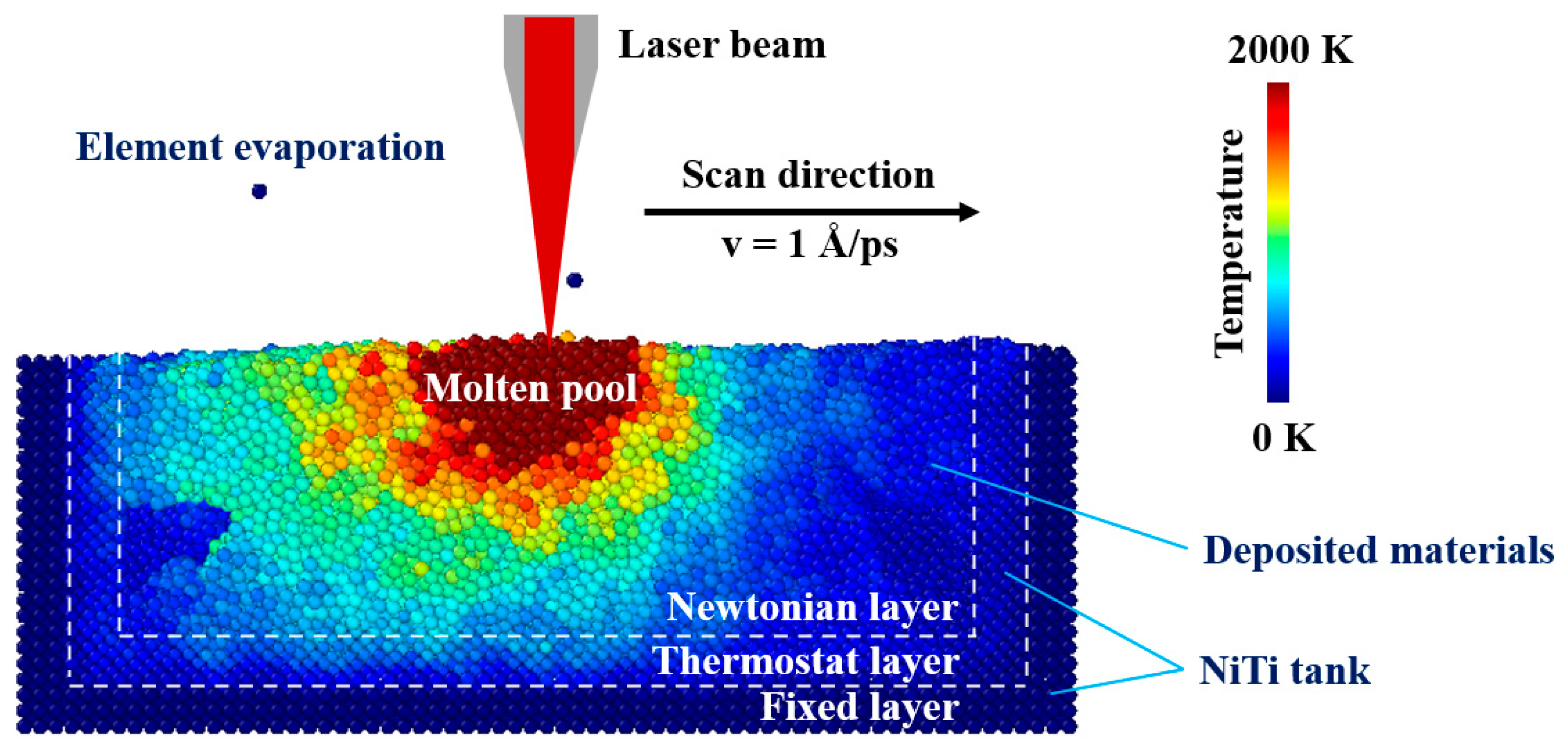
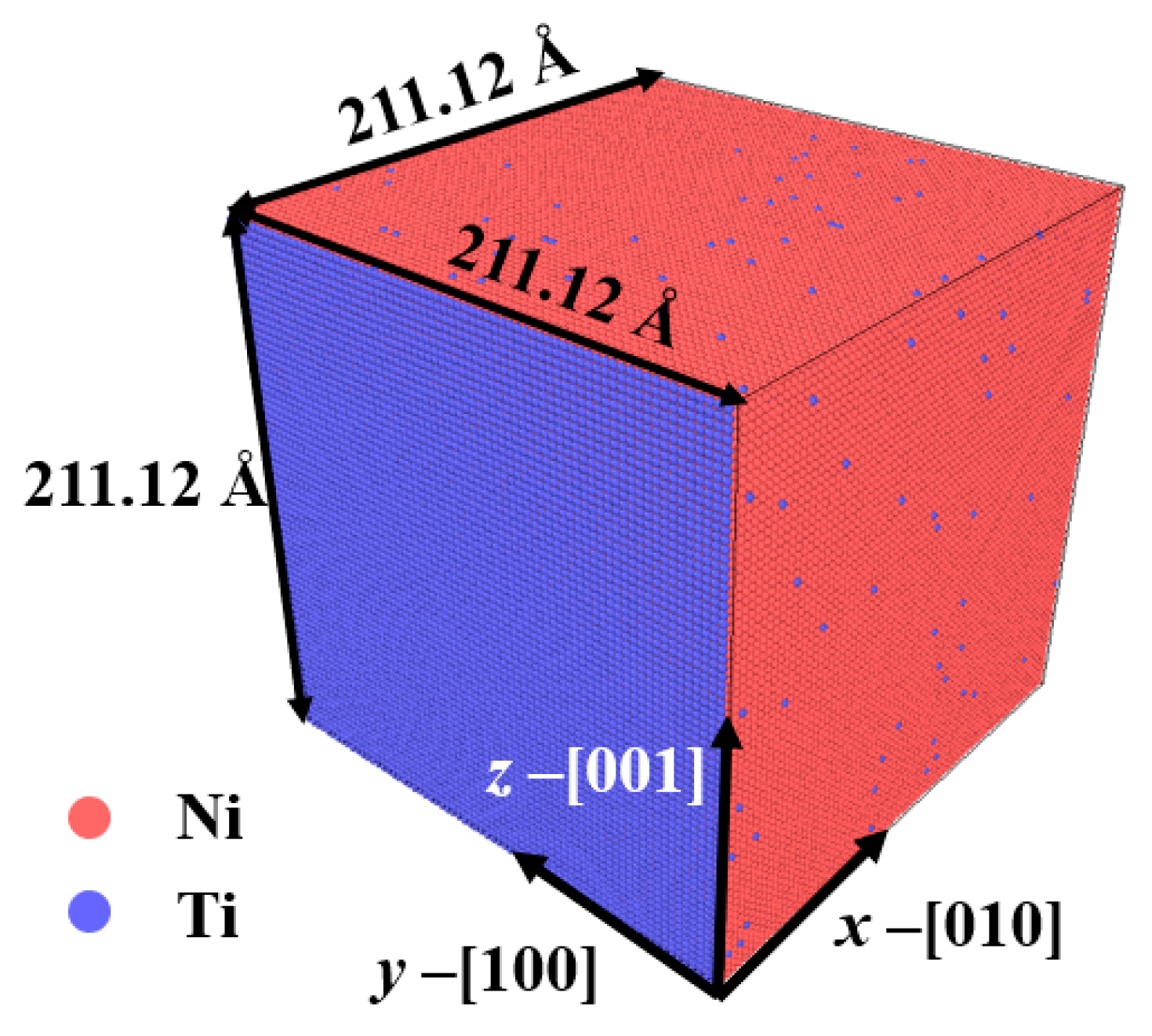

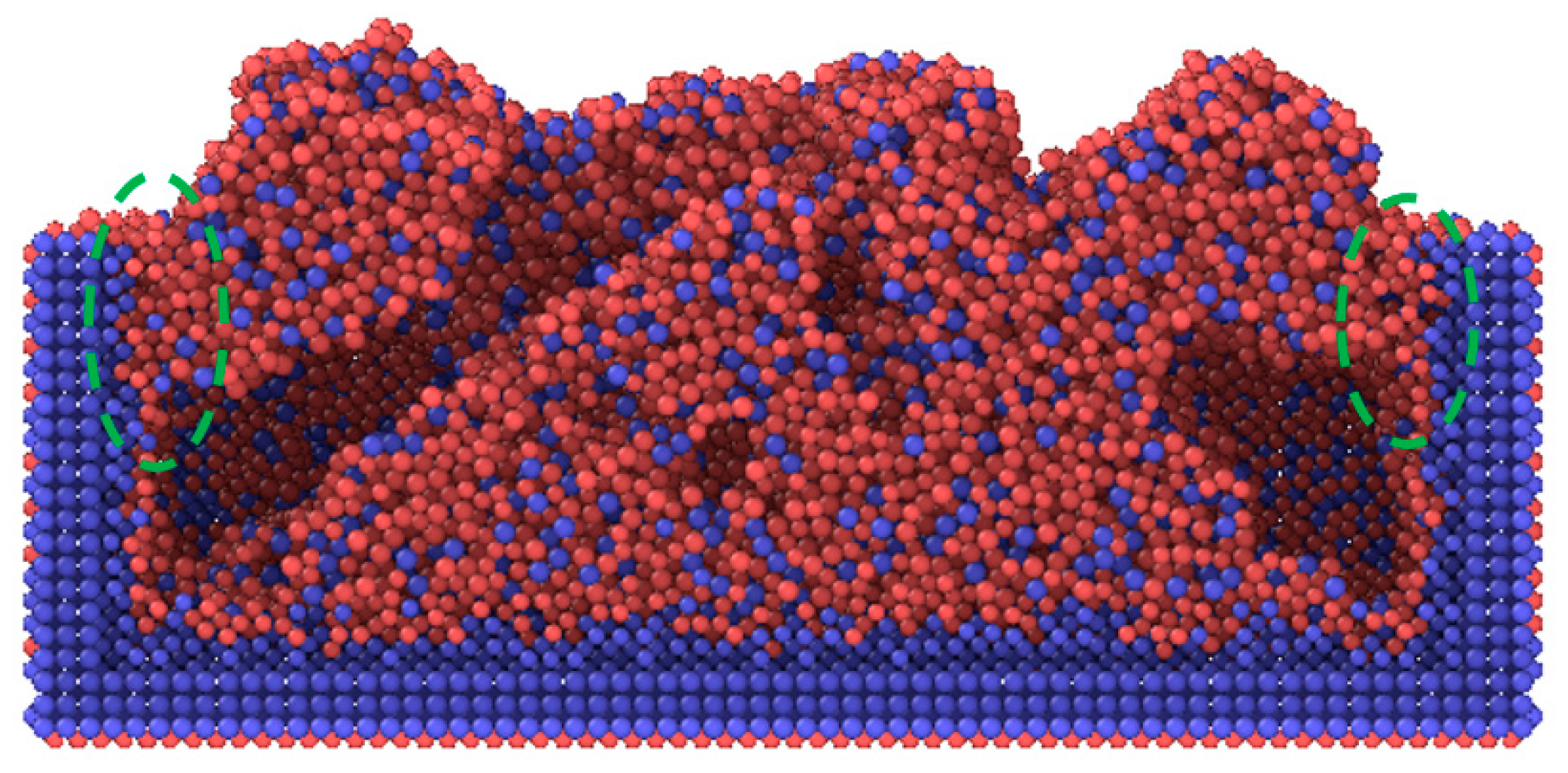
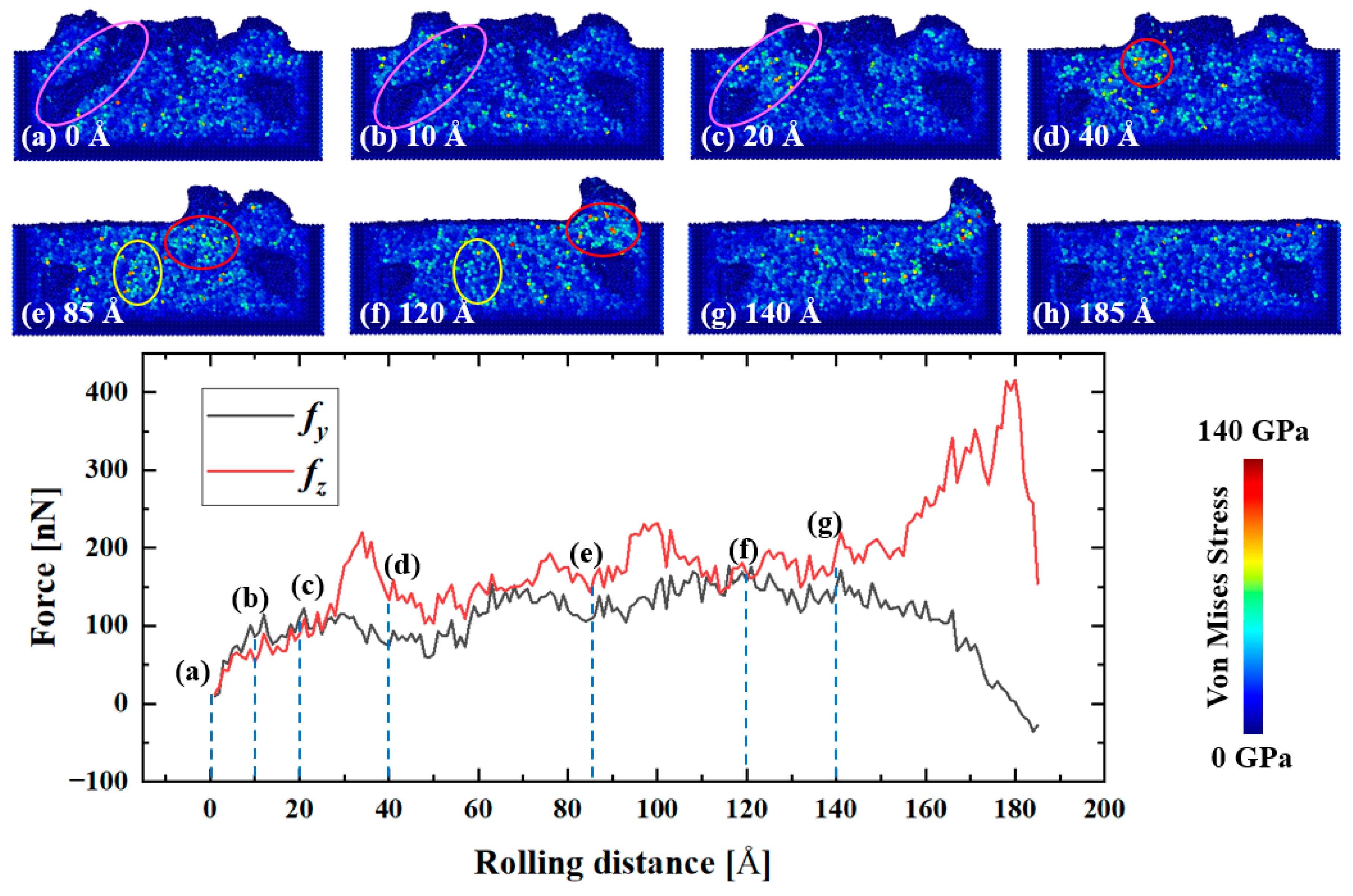
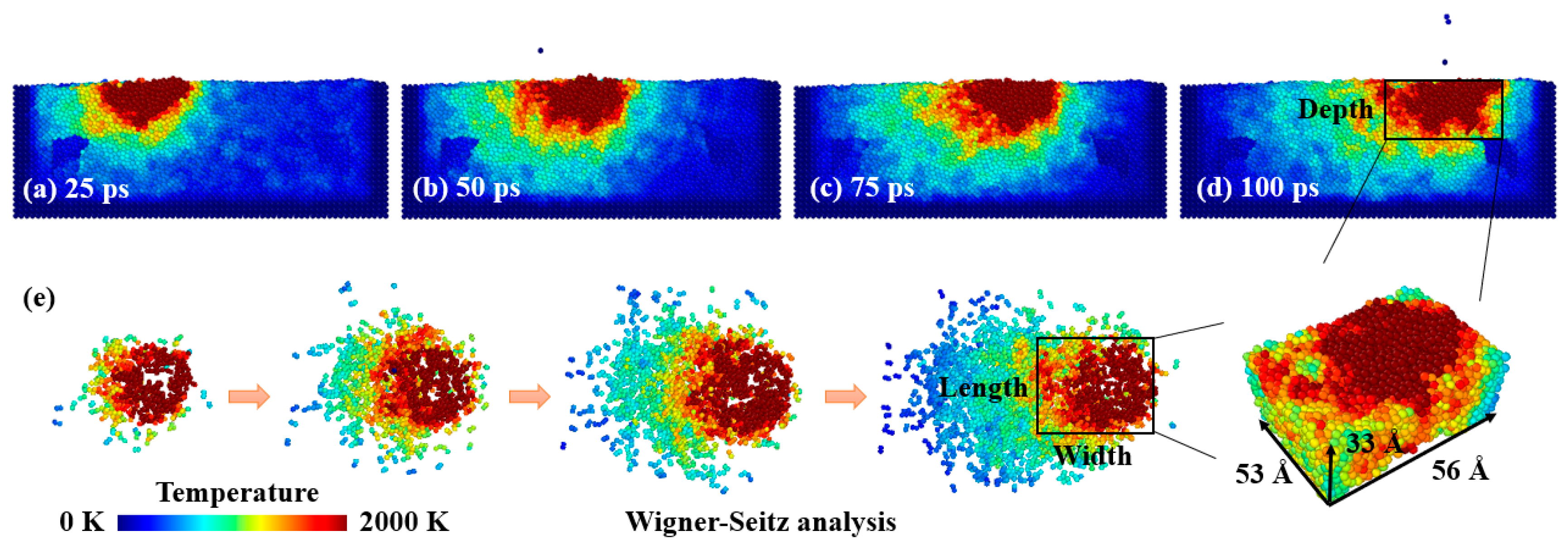

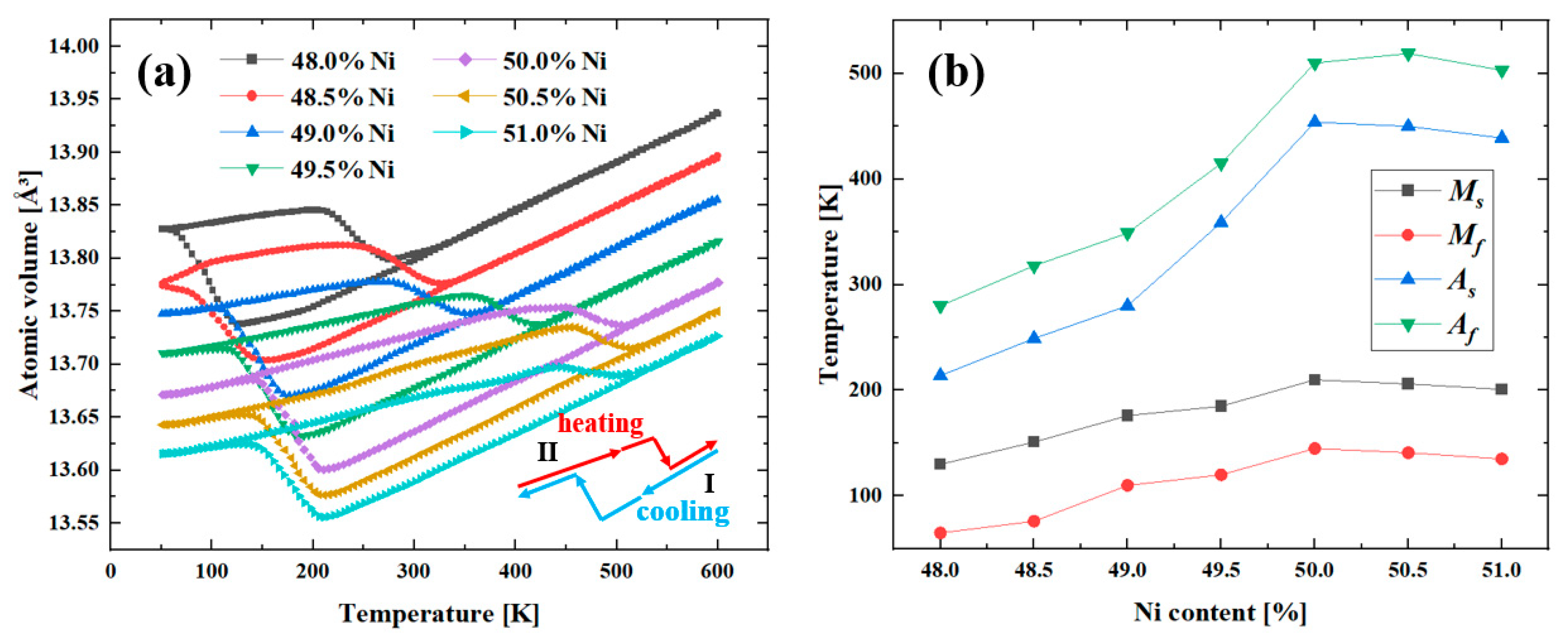

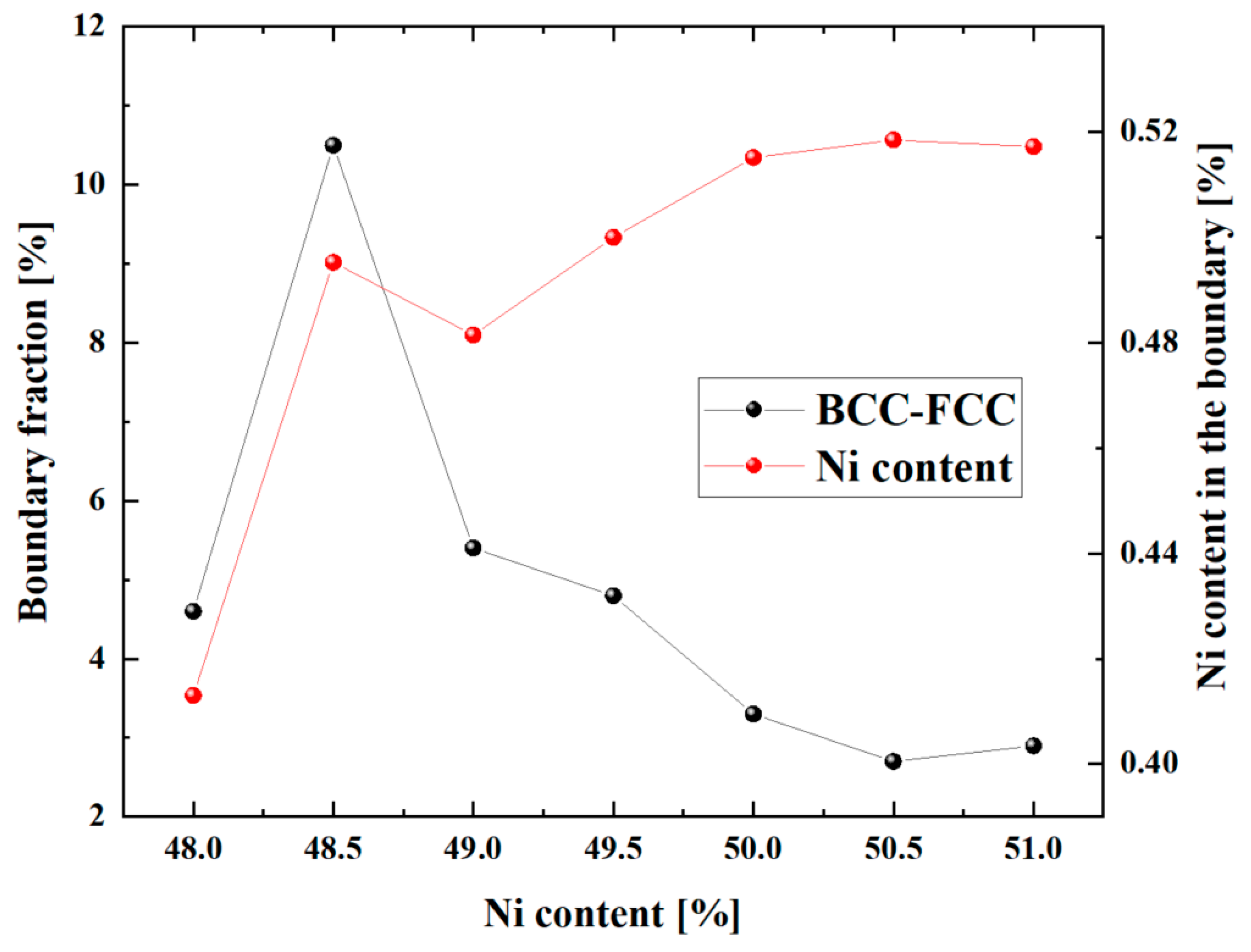


| No. | Laser Power (eV/ps) | Spot Diameter (Å) | Scanning Speed (Å/ps) | Molten Pool Size (ų) | Ni content (at. %) | Nieva a | Tieva b |
|---|---|---|---|---|---|---|---|
| 1 | 120 | 15 | 1 | 40 × 38 × 20 | 48.4 | 49 | 18 |
| 2 | 120 | 20 | 1 | 40 × 38 × 25 | 49.8 | 2 | 2 |
| 3 | 120 | 25 | 1 | 44 × 35 × 25 | 50.0 | 1 | 0 |
| 4 | 180 | 15 | 1 | 46 × 41 × 29 | 48.9 | 175 | 101 |
| 5 | 180 | 20 | 0.5 | 58 × 60 × 35 | 49.2 | 172 | 84 |
| 6 | 180 | 20 | 1 | 53 × 56 × 33 | 49.5 | 61 | 15 |
| 7 | 180 | 20 | 2 | 51 × 52 × 25 | 49.9 | 11 | 3 |
| 8 | 180 | 20 | 5 | 35 × 50 × 20 | 50.2 | 6 | 0 |
| 9 | 180 | 25 | 1 | 55 × 56 × 33 | 49.6 | 4 | 3 |
| 10 | 240 | 15 | 1 | 51 × 52 × 35 | 49.3 | 224 | 160 |
| 11 | 240 | 20 | 1 | 58 × 68 × 35 | 49.8 | 168 | 97 |
| 12 | 240 | 25 | 1 | 60 × 77 × 35 | 49.8 | 51 | 19 |
Disclaimer/Publisher’s Note: The statements, opinions and data contained in all publications are solely those of the individual author(s) and contributor(s) and not of MDPI and/or the editor(s). MDPI and/or the editor(s) disclaim responsibility for any injury to people or property resulting from any ideas, methods, instructions or products referred to in the content. |
© 2023 by the authors. Licensee MDPI, Basel, Switzerland. This article is an open access article distributed under the terms and conditions of the Creative Commons Attribution (CC BY) license (https://creativecommons.org/licenses/by/4.0/).
Share and Cite
Li, G.; Yu, T.; Wu, P.; Chen, M. Molecular Dynamics Simulation of NiTi Shape Memory Alloys Produced by Laser Powder Bed Fusion: Laser Parameters on Phase Transformation Behavior. Materials 2023, 16, 409. https://doi.org/10.3390/ma16010409
Li G, Yu T, Wu P, Chen M. Molecular Dynamics Simulation of NiTi Shape Memory Alloys Produced by Laser Powder Bed Fusion: Laser Parameters on Phase Transformation Behavior. Materials. 2023; 16(1):409. https://doi.org/10.3390/ma16010409
Chicago/Turabian StyleLi, Guotai, Tianyu Yu, Pan Wu, and Mingjun Chen. 2023. "Molecular Dynamics Simulation of NiTi Shape Memory Alloys Produced by Laser Powder Bed Fusion: Laser Parameters on Phase Transformation Behavior" Materials 16, no. 1: 409. https://doi.org/10.3390/ma16010409
APA StyleLi, G., Yu, T., Wu, P., & Chen, M. (2023). Molecular Dynamics Simulation of NiTi Shape Memory Alloys Produced by Laser Powder Bed Fusion: Laser Parameters on Phase Transformation Behavior. Materials, 16(1), 409. https://doi.org/10.3390/ma16010409








